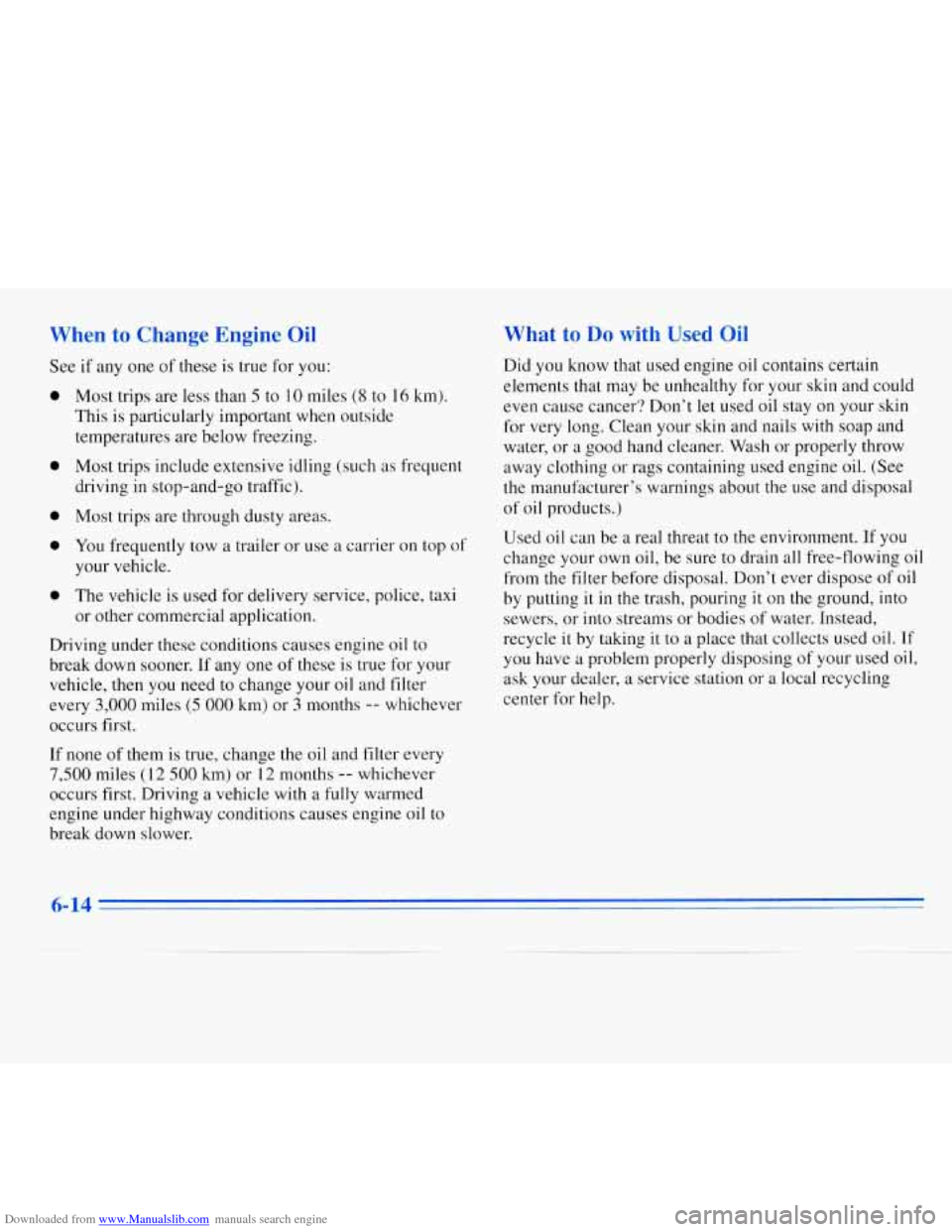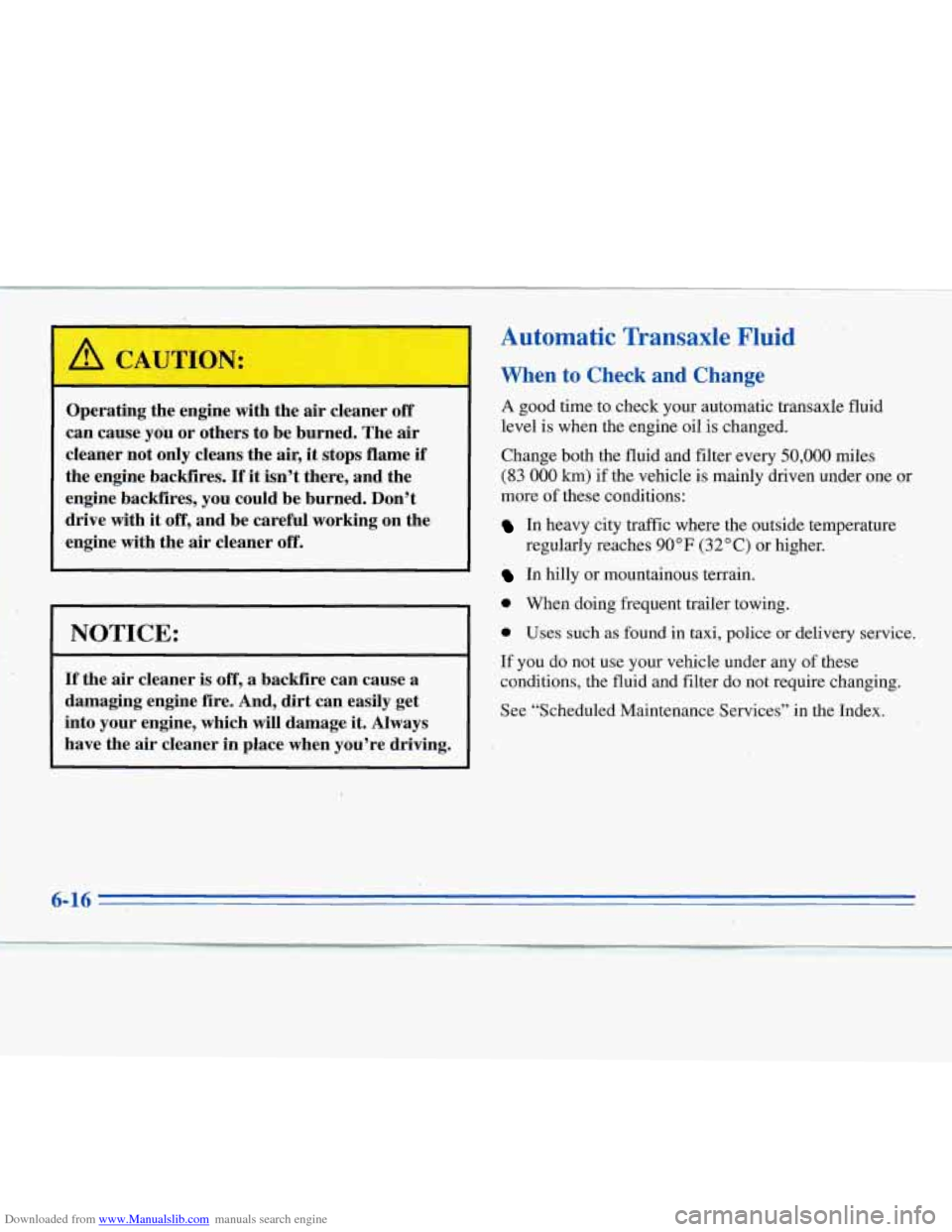Page 200 of 340
Downloaded from www.Manualslib.com manuals search engine L
6. Remove any rust or dirt
from the wheel bolts,
mounting surfaces and
spare wheel.
Rust or dirt on the wheel, or on the parts to
which it
is fastened, can make the wheel nuts
become loose after
a time. The wheel could come
off and cause an accident. When you change
a
wheel, remove any rust or dirt from the places
where the wheel attaches to the vehicle. In an
emergency, you can use a cloth or a paper towel
to do this; but be sure to use a scraper or wire
brush later,
if you need to, to get all the rust or
dirt off.
,- , ,. ,.
Never use oil or grease on studs or nuts. If you
do, the nuts might come loose. Your wheel could
fall off, causing a serious accident.
7. Replace the wheel nuts
with the rounded end
of the nuts toward the
wheel. Tighten each
nut
by hand until the wheel
is held against the
hub.
5-28
Page 206 of 340

Downloaded from www.Manualslib.com manuals search engine If You’re Stuck: In Sand, Mud,
Ice or Snow I NOTICE:
What you don’t want to do when your vehicle is stuck is
to spin your wheels too fast. The method known
as
“rocking” can help you get out when you’re stuck, but
you must use caution.
Spinning your wheels can destroy parts of your
vehicle as well as the tires.
If you spin the wheels
too fast while shifting your transaxle back and
forth, you can destroy your transaxle.
If you let your tires spin at high speed, they can
explode, and you or others could be injured.
And, the transaxle
or other parts of the vehicle
can overheat. That could cause an engine
compartment fire
or other damage. When you’re
stuck, spin the wheels as little
as possible. Don’t
spin the wheels above
35 mph (55 km/h) as shown
on the speedometer.
For information about using tire chains on your vehicle,
see “Tire Chains”
in the Index.
Rocking Your Vehicle to Get it Out
First, turn your steering wheel left and right. That will
clear the area around your front wheels. Then shift back
and forth between REVERSE
(R) and a forward gear,
spinning
the wheels as little as possible. Release the
accelerator pedal while you shift, and press lightly on
the accelerator pedal when the transaxle is
in gear. If
that doesn’t get you out after
a few tries, you may need
to be towed out.
If you do need to be towed out, see
“Towing Your Vehicle”
in the Index.
5-34
Page 218 of 340
Downloaded from www.Manualslib.com manuals search engine ,/ : t
I
I
3.4L LQ1 (Code X) Engine
Checking Engine Oil
Pull out the,dipstick and clean it with a paper towel or
cloth, then push it back in all the way, Remove it again,
keeping the tip down, and check the level.
When to Add Oil
If the oil is at or below the upper mark, then you’ll need
to add some oil. But you must use the right kind. This
part explains what kind of oil to use. For crankcase
capacity, see “Capacities and Specifications” in
the Index.
Turn
off the engine and give the oil 20 minutes to drain
back into the oil pan. If you don’t, the oil dipstick might
not show the actual level. NOTICE:
Don’t add too much oil. If your engine’has SO
much oil that the oil level gets above the
cross-hatched area that shows the proper
operating range, your engine could be damaged.
6-10
Page 222 of 340

Downloaded from www.Manualslib.com manuals search engine When to Change Engine Oil
See if any one of these is true for you:
0
0
0
0
0
Most trips are less than 5 to 10 miles (8 to 16 km).
This
is particularly important when outside
temperatures are below freezing.
Most trips include extensive idling (such
as frequent
driving in stop-and-go traffic).
Most trips are through dusty areas.
You frequently tow a trailer or use a carrier on top of
your vehicle.
The vehicle is used for delivery service, police, taxi
or other commercial application.
Driving under these conditions causes engine oil to
break down sooner.
If any one of these is true for your
vehicle, then you need to change your oil and filter
every
3,000 miles (5 000 km) or 3 months -- whichever
occurs first.
What to Do with Used Oil
Did you know that used engine oil contains certain
elements that may be unhealthy for your skin and could
even cause cancer? Don’t
let used oil stay on your skin
for very long. Clean your skin and nails
with soap and
water, or a good hand cleaner. Wash or properly throw
away clothing or rags containing used engine oil. (See
the manufacturer’s warnings about
the use and disposal
of oil products.)
Used oil can be a real threat to the environment. If you
change your own oil, be sure to drain all free-flowing oil
from the filter before disposal. Don’t ever dispose of oil
by putting
it in the trash, pouring it on the ground, into
sewers, or into streams or bodies of water. Instead,
recycle
it by taking it to a place that collects used oil. If
you have a problem properly disposing of your used oil,
ask your dealer, a service station or
a local recycling
center for help.
If none of them is true, change the oil and filter every
7,500 miles (12 500 km) or 12 months -- whichever
occurs first. Driving
a vehicle with a fully warmed
engine under highway conditions causes engine
oil to
break down slower.
6-14
Page 224 of 340

Downloaded from www.Manualslib.com manuals search engine -
,A CAUTION:
Operating the engine with the air cleaner off
can cause you or others to be burned. The air
cleaner not only cleans the air, it stops flame if
the engine backfires. If it isn’t there, and the
engine backfires, you could be burned. Don’t
drive with
it off, and be careful working on the
engine with the
air cleaner off.
NOTICE:
If the air cleaner is off, a backfire can cause a
damaging engine fire. And, dirt can easily get
into your engine, which will damage it. Always
have the air cleaner in place when you’re driving.
Automatic Transaxle Fluid
When to Check and Change
A good time to check your automatic transaxle fluid
level is when the engine oil is changed.
Change both the fluid and filter every
50,000 miles
(83 000 km) if the vehicle is mainly driven under one or
more
of these conditions:
In heavy city traffic where the outside temperature
In hilly or mountainous terrain.
0 When doing frequent trailer towing.
0 Uses such as found in taxi, police or delivery service.
If you do not use your vehicle under any of these
conditions, the fluid and filter do not require changing.
See “Scheduled Maintenance Services’’ in the Index.
regularly reaches
90°F (32°C) or
higher.
6-16 .
Page 226 of 340
Downloaded from www.Manualslib.com manuals search engine Then, without shutting off the engme, follow these steps:
3.1
L L82 (Code M) Engine 3.4L LQl (Code X) Engine
1, The
transaxle fluid dipstick handle is the red loop
near the back
of the engine. Pull out the dipstick and
wipe
it with a clean rag or paper towel.
2. Push it back
in all the way, wait three seconds and
then pull it back out again.
3.1 L L82 (Code M) Engine 3.4L LQI. (Code X) Engine
3. Check both sides
of the dipstick, and read the
lower level. The
fluid level must be in the
cross-hatched area.
4. If the fluid level is in the acceptable range, push the
dipstick back in all the way.
4-18
Page 247 of 340

Downloaded from www.Manualslib.com manuals search engine After the tires have been rotated, adjust the front and
rear inflation pressures as shown on the Tire-Loading
Information label. Make certain that all wheel nuts are properly tightened. See “Wheel Nut Torque” in
I1 the Index.
I
When It’s Time for New Tires
(
Rust or dirt on a wheel, or on the parts to which
it is fastened, can make wheel nuts become loose
after
a time. The wheel could come off and cause
an accident. When you change a wheel, remove
any rust or
dirt from places where the wheel
attaches to the vehicle. In an emergency, you can
use a cloth or a paper towel to do this; but be
sure to use a scraper
or wire brush later, if you
need to, to get all the rust or dirt off. (See
‘(Changing
a Flat Tire? in the Index.)
One way to tell when it’s
time for new tires is to
check the treadwear indicators, which will appear when your tires have
only 1/16 inch (1.6
mm) or
less of tread remaining.
You need a new tire if any of the following statements
are true:
You can see the indicators at three or more places
around the tire.
You can see cord or fabric showing through the
tire’s rubber.
The tread or sidewall is cracked, cut or snagged deep
enough to show cord or fabric.
0 The tire has a bump, bulge or split.
The tire has a puncture, cut or other damage that
can’t be repaired well because of the size or location
of the damage.
6-39
Page 253 of 340

Downloaded from www.Manualslib.com manuals search engine Using Foam-Type Cleaner on Fabric
0
0
0
0
0
0
0
0
0
0
e
Vacuum and brush the area to remove any loose dirt.
Always clean a whole trim panel or section. Mask
surrounding trim along stitch or welt lines.
Mix Multi-Purpose Powdered Cleaner following the
directions on the container label.
Use suds only and apply with a clean sponge.
Don’t saturate
the material.
Don’t rub
it roughly.
As soon as you’ve cleaned the section, use a sponge
to remove the suds.
Rinse the section with a clean, wet sponge.
Wipe off what’s left with
a slightly damp paper towel
or cloth.
Then dry
it immediately with a blow dryer.
Wipe with a clean cloth.
Using Solvent-wpe Cleaner on Fabric
First, see if you have to use solvent-type cleaner at all.
Some spots and stains will clean off better with just
water and mild soap. If you
need to use a solvent:
0 Gently scrape excess soil from the trim material with a
clean, dull knife or scraper. Use very little cleaner, light
pressure and clean cloths (preferably cheesecloth).
Cleaning should
start at the outside of the stain,
“feathering” toward the center. Keep changing to a
clean section
of the cloth.
0 When you clean a stain from fabric, immediately
dry the area with a blow dryer to help prevent a
cleaning ring.
Fabric Protection
Your Chevrolet has upholstery and carpet that has been
treated with Scotchgard” Fabric Protector,
a 3M
product. It protects fabrics by repelling oil and water,
which are the carriers of most stains. Even with this
protection, you still need to clean your upholstery and
carpet often to keep it looking new.
Further information on cleaning
is available by calling
1-800-433-3296 (in Minnesota, 1-800-642-6
167).
6-45